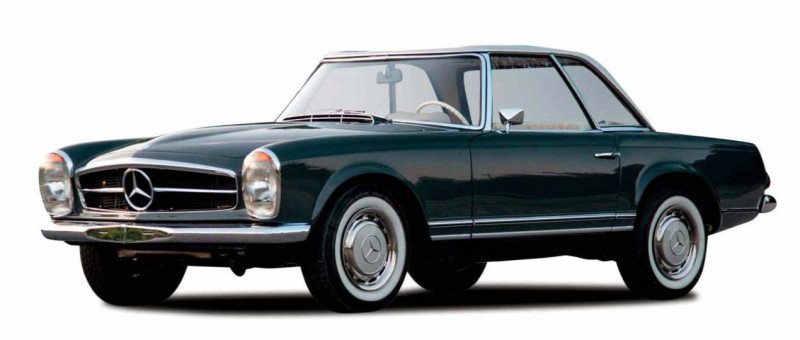An enduring icon 1963 Mercedes-Benz 250SL W113
It may have arrived to a cool reception, but this Merc’s appeal is timeless
Fashions fade, style is eternal. So said 20th-century icon Yves St Laurent, and to back him up we’d point to the enduring and understated elegance of the Mercedes-Benz ‘pagoda’ SL roadster.

The deceptively simple form was penned by Frenchman Paul Bracq, head stylist for Mercedes-Benz from 1957-1967, where he also drew the W114 E-Class sedan and 600 grosser – models that, like the SL, dispensed with the fi ns and fuss of their predecessors.
The SL was quietly revolutionary, a conscious distancing from sports and racing cues in the wake of Benz’s 1955 Le Mans experience. The thrusting curves and haunches of 1950s and ’60s roadsters were now merely hinted in one graceful arc and a single, tensed muscle along the rear quarter panels. The tall, generous glass was said to have prompted the distinctive, concave ‘pagoda’ hardtop roof – Bracq’s trick to prevent the car from looking top-heavy.
Funny to think that when the W113 launched in 1963 at the Geneva Salon in Switzerland, the market was underwhelmed. It was admittedly hard to follow the technological tour de force of the W198 300 SL ‘gullwing’ coupe and roadster and surprisingly, even the sedan-based, four-cylinder 190 SL (R121), which deceived with the extravagant styling of the spaceframe supercars.
Created under legendary chief engineer Rudolf Uhlenhaut, the W113 was technically advanced in its own way. The steel monocoque chassis featured cast aluminium door frames and aluminium door skins, bonnet and boot lid, though the SL would be no lightweight at 1350-plus kilos. Those panels, and the hardtop when specified, were numbered to each car. The SL’s driving was modern, sophisticated, comfortable and effortless, most particularly with the optional power steering and the popular (and no slower) four-speed automatic transmission. The initial 2.3-litre 230 SL gave way to a 2.5 litre (250 SL) in January 1967, and 2.8-litre 280 SL in December 1967.
A price tag roughly double that of a Jaguar E-Type bought impeccable quality, safety, comfort and exclusivity, but not performance: both the Jag and a contemporary Porsche 911 were a good two seconds faster than even the 280 SL’s 9.3-second 0-60mph acceleration.
Production of the 280 SL ceased in March 1971 after a total of 48,912 W113s, giving way to the anything-but sporty and light R107 SL series.
INTO THE SWING OF IT
The SL’s chassis was a shortened version of the W111 sedan’s and was the first Mercedes sports car to embody the passive safety principles of engineer Bela Barényi. Suspension was also sedan-derived, with double wishbones up front and swing axles and semi-trailing arms at the rear, on 14-inch wheels. Not sparing the comfort (or the chrome) inside pushed the 250 SL’s kerb weight to 1360kg, with the hardtop adding 49kg.
FAVOURING AUTOMATION
The 2306cc, four-bearing in-line sohc 12v Six of the the 230 SL gave way to a stronger, Seven-bearing bottom end for the stroked 2496cc (250) and bored 2778cc (280) versions. All had mechanical fuel injection and where praised as responsive and rev-happy, and power/torque rose from 110kW/196Nm 230 through 110kW/216Nm (250), to 130kW/240Nm (280). Where three-quarters Of 230 SLs were manuals, the 280 SLs 90 percent automatics.
5196 250 SLs produced, making this the rarest RARE,
3 OPTIONAL SIDEWAYS-FACING THIRD SEAT
1963 230 SL wins the 5500km Spa-Sofi a-Liege road rally (Eugen Böhringer and Klaus Kaiser)
241,000 US dollars paid at auction in 2019 for a 1971 280 SL – likely a record

